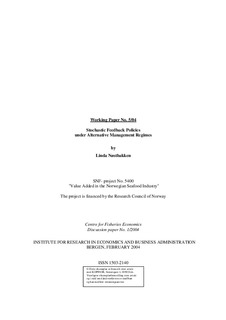| dc.contributor.author | Nøstbakken, Linda | |
| dc.date.accessioned | 2006-06-29T07:50:59Z | |
| dc.date.available | 2006-06-29T07:50:59Z | |
| dc.date.issued | 2004-02 | |
| dc.identifier.issn | 1503-2140 | |
| dc.identifier.uri | http://hdl.handle.net/11250/165670 | |
| dc.description.abstract | A discrete-time stochastic bioeconomic model is developed and used to analyse the North Sea herring fishery under alternative management regimes. The analysis focuses on how catches and harvesting policies change with the price of herring. Two production functions are used to explain the harvesting process. At small stock levels, the choice of production function is seen to be critical for the model’s predictions. Feedback policies are found for the optimally managed fishery. The management of North Sea herring, after a moratorium was lifted in 1981, is evaluated with respect to effects on supply, stock level, and fishing effort. Under optimal management, the results imply that the fishery should have stayed closed until 1983, a conclusion that is independent of harvesting relationship used. Whether open access leads to total depletion or not is seen to depend on the choice of production function. | en |
| dc.format.extent | 204183 bytes | |
| dc.format.mimetype | application/pdf | |
| dc.language.iso | eng | en |
| dc.publisher | SNF/Centre for Fisheries Economics | en |
| dc.relation.ispartofseries | Working paper | en |
| dc.relation.ispartofseries | 2004:5 | en |
| dc.relation.ispartofseries | Discussion paper | en |
| dc.relation.ispartofseries | 2004:1 | en |
| dc.title | Stochastic feedback policies under alternative management regimes | en |
| dc.type | Working paper | en |
